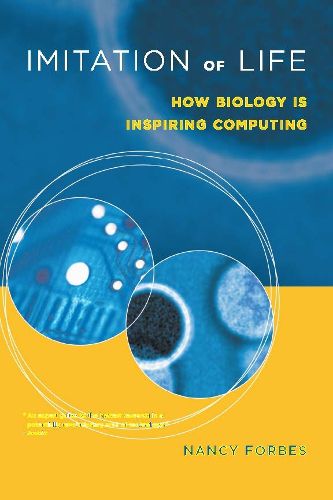Readings Newsletter
Become a Readings Member to make your shopping experience even easier.
Sign in or sign up for free!
You’re not far away from qualifying for FREE standard shipping within Australia
You’ve qualified for FREE standard shipping within Australia
The cart is loading…






As computers and the tasks they perform become increasingly complex, researchers are looking to nature – as model and as metaphor – for inspiration. The organization and behavior of biological organisms present scientists with an invitation to reinvent computing for the complex tasks of the future. In Imitation of Life, Nancy Forbes surveys the emerging field of biologically inspired computing, looking at some of the most impressive and influential examples of this fertile synergy.Forbes points out that the influence of biology on computing goes back to the early days of computer science – John von Neumann, the architect of the first digital computer, used the human brain as the model for his design. Inspired by von Neumann and other early visionaries, as well as by her work on the Ultrascale Computing project at the Defense Advanced Research Projects Agency (DARPA), Forbes describes the exciting potential of these revolutionary new technologies. She identifies three strains of biologically inspired computing: the use of biology as a metaphor or inspiration for the development of algorithms; the construction of information processing systems that use biological materials or are modeled on biological processes, or both; and the effort to understand how biological organisms compute, or process information.Forbes then shows us how current researchers are using these approaches. In successive chapters, she looks at artificial neural networks; evolutionary and genetic algorithms, which search for the fittest among a generation of solutions; cellular automata; artificial life – not just a simulation, but alive in the internal ecosystem of the computer; DNA computation, which uses the encoding capability of DNA to devise algorithms; self-assembly and its potential use in nanotechnology; amorphous computing, modeled on the kind of cooperation seen in a colony of cells or a swarm of bees; computer immune systems; bio-hardware and how bioelectronics compares to silicon; and the computational properties of cells.
$9.00 standard shipping within Australia
FREE standard shipping within Australia for orders over $100.00
Express & International shipping calculated at checkout
As computers and the tasks they perform become increasingly complex, researchers are looking to nature – as model and as metaphor – for inspiration. The organization and behavior of biological organisms present scientists with an invitation to reinvent computing for the complex tasks of the future. In Imitation of Life, Nancy Forbes surveys the emerging field of biologically inspired computing, looking at some of the most impressive and influential examples of this fertile synergy.Forbes points out that the influence of biology on computing goes back to the early days of computer science – John von Neumann, the architect of the first digital computer, used the human brain as the model for his design. Inspired by von Neumann and other early visionaries, as well as by her work on the Ultrascale Computing project at the Defense Advanced Research Projects Agency (DARPA), Forbes describes the exciting potential of these revolutionary new technologies. She identifies three strains of biologically inspired computing: the use of biology as a metaphor or inspiration for the development of algorithms; the construction of information processing systems that use biological materials or are modeled on biological processes, or both; and the effort to understand how biological organisms compute, or process information.Forbes then shows us how current researchers are using these approaches. In successive chapters, she looks at artificial neural networks; evolutionary and genetic algorithms, which search for the fittest among a generation of solutions; cellular automata; artificial life – not just a simulation, but alive in the internal ecosystem of the computer; DNA computation, which uses the encoding capability of DNA to devise algorithms; self-assembly and its potential use in nanotechnology; amorphous computing, modeled on the kind of cooperation seen in a colony of cells or a swarm of bees; computer immune systems; bio-hardware and how bioelectronics compares to silicon; and the computational properties of cells.